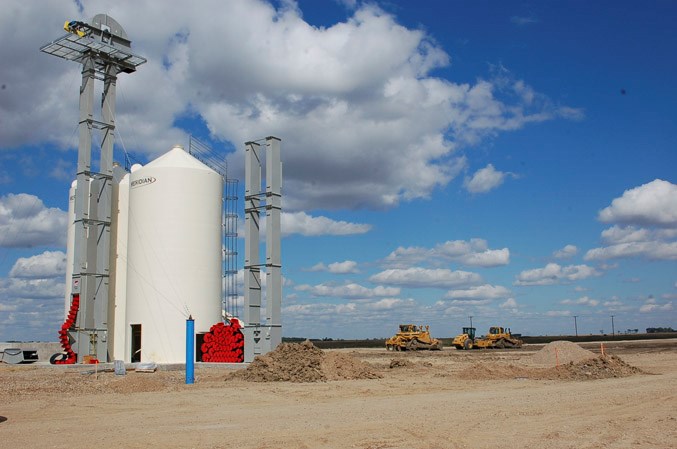A dual grain and oil transloading project that straddles the Saskatchewan-North Dakota border at Northgate is about 90 per cent completed in its first phase.
Ceres Global Ag Corp. of Toronto and its minor shareholder partner, VN Capital Management of New York, said this past week that the dual looped rail line that will be used by Burlington Northern, Santa Fe (BNSF) Rail to move these two major products out of province and into American refineries and markets is almost ready. Gravel hauling trucks are working fiendishly on-site to help the planners and developers finish their jobs.
"The loop track should be completed by October," said James Vanasek of UN Capital, who was serving as spokesman for the two companies in speaking with the Mercury on Aug. 28.
The company will begin loading grain from the transloading facility later this year as long as there are no more weather-related delays. The connection between the Canadian and American rail lines was completed last year so the only need is to finish laying the loop track on the Canadian side.
Next year will see the construction of a $40 million 2.4 million bushel terminal on the site to assist the grain storage and loading capabilities. For starters though, Ceres expects to be able to load as many as 72 grain cars, about 300,000 bushels per week by directly transloading them from grain hauling semis.
"Farmers will be glad to see the new capacity come on stream, I'm sure," said Vanasek.
The BNSF rail network will be able to take the grain and canola right to Minneapolis, Duluth, Chicago or Tacoma from southern Saskatchewan. "We'll probably see some canola heading for Mexico too," he added.
The total project cost, estimated at around $80 million a couple of years ago, has remained pretty well on financial target in spite of the delays due to weather.
On-site project managers have conscripted expertise in construction and excavation from Estevan-based businesses and other nearby subcontractors.
BNSF has spent $20 million in rail upgrades in anticipation of the extended and expanded services they will be expected to provide, and U.S. and Canadian customs services have been apprised of the company's intentions well in advance and are prepared for the fresh influx of traffic. Vanasek said all international approvals have been sought and gained.
Shortly after the grain starts to move, he said he expects the oil movement to begin, too.
There have been inquiries made regarding the possibility of bringing fracking sand for the oil industry and fertilizers for the agriculture industries north on the BNSF trains in the future.
"There are a number of exciting possibilities surfacing. We haven't taken them beyond the exploratory stages yet, so there is nothing definitive to say on that subject right now," Vanasek added.
A manager and senior administrative personnel that will put the facility into operational mode will probably be on site within a week or two. Tim Koch is set as operations manager for the upcoming grain terminal project.
Once the oil and natural gas liquids begin moving, Ceres will be able to put about 70,000 barrels per day onto the track and into U.S. markets.
"The horizontal build has taken up about $30 million, another $5 million has been invested in the temporary transloading infrastructure and as we said earlier, the grain terminal will be about $40 million," said Vanasek.
The Northgate project is spread out over 1,500 acres, which leaves plenty of room for expansion and environmental protection assurances. When it is fully operational, the site will employ up to 30 people.
Northgate is located in the RM of Enniskillen, a few kilometres southwest of Oxbow.
"The site is an attractive one for oil and agricultural producers and we believe we can be part of the solution for them in terms of moving their products to markets," said Vanasek.




